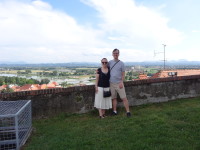 We woke up in Zagreb, Croatia, which is important to establish on a trip that covers three countries in fourteen days. We showered and got ready, and moseyed out to a bakery on the main square to pick up some breakfast pastries, which we took back to our hostel and ate in their lovely enclosed courtyard.
We woke up in Zagreb, Croatia, which is important to establish on a trip that covers three countries in fourteen days. We showered and got ready, and moseyed out to a bakery on the main square to pick up some breakfast pastries, which we took back to our hostel and ate in their lovely enclosed courtyard.
Then we packed up, checked out, and set out to pick up our rental car. With the help of Google Maps (thank you!), we figured out which tram and then which bus to take to get to the car rental place. We got there with only a little difficulty in finding the bus stop. It turned out that their computer system was down, so they drove us back out to the airport and dropped us there. The computer was down there as well, but the young man at the desk filled out the forms by hand and away we drove, listening to Cat Stevens and the Beatles on Croatian radio. We were headed to Ptuj (pit-too-ey) in Slovenia, a trip of only a little over an hour, made much easier by my strangely-ahead-of-the-game thought to buy a GPS with the Europe maps loaded on it, a week before we left home. It worked like a charm.
The roads in Croatia are excellent, with the highway having a speed limit of 80 mph. When we got close to the border, we had to go through several tunnels in smaller mountains. The border crossing was almost effortless – the guards on both sides of the border looked at our passports and the Slovenian guard stamped them.
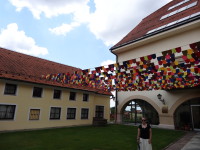 We arrived at Ptuj around noon. I found the town to be charming – it is built on a small hill, with a scenic river out in front, and red-tiled homes huddled together. We found our B and B, an amazing little place called Silak (shee-lahk). It is run by a very friendly couple who informed us the house is between five hundred and eight hundred years old (the oldest records were lost in a fire, so they do not know for sure). It is always humbling to sleep somewhere older than my country. The B and B has beautiful exposed beams, marble tile in the bathroom, slanting roofs (which Mer has always loved), air conditioning, and internet access. I highly recommend it.
We arrived at Ptuj around noon. I found the town to be charming – it is built on a small hill, with a scenic river out in front, and red-tiled homes huddled together. We found our B and B, an amazing little place called Silak (shee-lahk). It is run by a very friendly couple who informed us the house is between five hundred and eight hundred years old (the oldest records were lost in a fire, so they do not know for sure). It is always humbling to sleep somewhere older than my country. The B and B has beautiful exposed beams, marble tile in the bathroom, slanting roofs (which Mer has always loved), air conditioning, and internet access. I highly recommend it.
 Once we dumped our stuff, we set out to wander the small town and to acquire some light lunch. On the recommendation of our host at the B and B, we stopped off at the library in town and made our way to the top floor. The top floor showed off an amazing array of exposed beams, and had good views of the river. We then wandered up the hill a bit, skipping the tempting stairs to the castle, and made our way through the old small square to the newer square, where we found a bakery. We munched on cheese bread while sitting on a bench outside the town hall, where we got to observe the very quiet town in all of its inaction. My kind of place.
Once we dumped our stuff, we set out to wander the small town and to acquire some light lunch. On the recommendation of our host at the B and B, we stopped off at the library in town and made our way to the top floor. The top floor showed off an amazing array of exposed beams, and had good views of the river. We then wandered up the hill a bit, skipping the tempting stairs to the castle, and made our way through the old small square to the newer square, where we found a bakery. We munched on cheese bread while sitting on a bench outside the town hall, where we got to observe the very quiet town in all of its inaction. My kind of place.
After lunch, we did head up to the castle. The castle is now a very eclectic museum, housing several collections. We started with the mask collection, which is really a costume collection of the costumes villagers wear for a parade late in winter. The parade is designed to drive off winter and bring in spring, so it has a fertility feel for much of it – plows and livestock and a display of eligible young men and women. The main focus of the parade is the flock of Kurent demons – people dressed up in wool, masks, horns, stick, and cowbells, who are supposed to frighten the winter away.
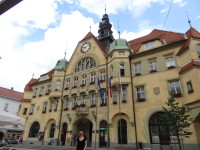 Once we had seen the mask museum, we entered the main section of the castle itself (which is more of a fortified mansion than a typical defensive castle). The main floor is now a museum of the furniture that had been used in the castle, from the 1700s until the 1900s. You can also see the three-hundred-year-old plastered ceilings with their still-intact ornamentations.
Once we had seen the mask museum, we entered the main section of the castle itself (which is more of a fortified mansion than a typical defensive castle). The main floor is now a museum of the furniture that had been used in the castle, from the 1700s until the 1900s. You can also see the three-hundred-year-old plastered ceilings with their still-intact ornamentations.
Next on the tour list was the castle’s festival hall, which is still used for concerts. The hall is surrounded by huge portraits of various people groups, mostly Turks, and all certainly done by people who had never seen a Turkish or a Chinese or a Native American person before.
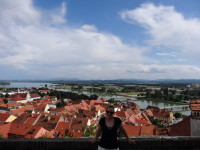 We headed upstairs to the third floor to look at the art collection of the castle, which is mostly paintings of the lords and ladies of Ptuj, along with copies of masterpieces done by local artists. That was fascinating – it was interesting to see why talented locals were not so good as world masters – it generally came down to details – background figures were not painted in detail, or foreground subjects had no life to them (no individual hairs on the head, clothes not fluid, etc.).
We headed upstairs to the third floor to look at the art collection of the castle, which is mostly paintings of the lords and ladies of Ptuj, along with copies of masterpieces done by local artists. That was fascinating – it was interesting to see why talented locals were not so good as world masters – it generally came down to details – background figures were not painted in detail, or foreground subjects had no life to them (no individual hairs on the head, clothes not fluid, etc.).
We wound our way down to the ground floor again to look at the musical instrument collection, which includes the remains of several rare Roman instruments. There are also sixteenth-century lutes, and a good collection of harpsichords and pianos, along with some old marching band instruments.
The last of the collection is the armory, where there were a couple of suits of armor, several small cannon, some firearms of various types and ages, and lots of swords. The most impressive part was they had a two-handed great sword lying out for people to heft for photographs. It was very heavy.
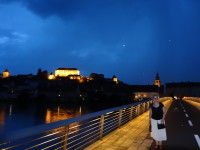 We had dodged a short but heavy rain while in the castle, and so with good weather we headed back to the B and B to regroup before supper. After a fifteen-minute rest, Mer took me to a local monastery that had been destroyed by bombs in World War 2, but had been rebuilt in stages from the 1980s to 2010. The church of the monastery is simple, modern, and one of the most beautiful churches I have ever seen. The stained glass is modern, with vibrant colors and shapes suggesting Biblical events instead of showing them outright. In one window was a shape suggesting Jesus wearing the crown of thorns. In another was probably a boat that could have been Jesus calming the storm or walking on the water, or could have been Noah’s ark. They were very impressive. The church also had modern art versions of the stations of the cross that were more suggestive than literal, and several of them were very moving. Inside the church was one older lady who was very friendly, but did not speak English. We both felt bad that we could not understand her, as she was talkative and seemed very proud of the church.
We had dodged a short but heavy rain while in the castle, and so with good weather we headed back to the B and B to regroup before supper. After a fifteen-minute rest, Mer took me to a local monastery that had been destroyed by bombs in World War 2, but had been rebuilt in stages from the 1980s to 2010. The church of the monastery is simple, modern, and one of the most beautiful churches I have ever seen. The stained glass is modern, with vibrant colors and shapes suggesting Biblical events instead of showing them outright. In one window was a shape suggesting Jesus wearing the crown of thorns. In another was probably a boat that could have been Jesus calming the storm or walking on the water, or could have been Noah’s ark. They were very impressive. The church also had modern art versions of the stations of the cross that were more suggestive than literal, and several of them were very moving. Inside the church was one older lady who was very friendly, but did not speak English. We both felt bad that we could not understand her, as she was talkative and seemed very proud of the church.
For supper, we swung by the room and then we walked the short distance over to the Amadeus restaurant, where we promptly ate too much. I made the mistake of thinking a “starter course” was an appetizer, when it really is a full meal in itself. I have no idea how the Italians, who eat multi-course meals often, do it. By the time my real meal came, I was comfortably full. I foraged on – it was a very good meal.
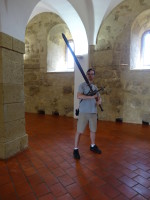 We saw some rain coming after supper, so we went back to the room to wait it out, which took about twenty minutes. Then, we strolled the town to a cute restaurant for dessert. The restaurant had a patio built around three trees that had the thickest foliage I have ever seen. As such, you sat under a canopy of leaves. It was pretty marvelous. We had some cake, and I got my first European hot chocolate of this trip – that I pretty much had to eat with a spoon (European hot chocolate is pretty thick). After a quick walk down to the river and across the pedestrian bridge for an evening view of Ptuj, we went back to the B and B to escape the rain that had just started up again. Thus ended Day Two of our little adventure.
We saw some rain coming after supper, so we went back to the room to wait it out, which took about twenty minutes. Then, we strolled the town to a cute restaurant for dessert. The restaurant had a patio built around three trees that had the thickest foliage I have ever seen. As such, you sat under a canopy of leaves. It was pretty marvelous. We had some cake, and I got my first European hot chocolate of this trip – that I pretty much had to eat with a spoon (European hot chocolate is pretty thick). After a quick walk down to the river and across the pedestrian bridge for an evening view of Ptuj, we went back to the B and B to escape the rain that had just started up again. Thus ended Day Two of our little adventure.
I thought Jo was going to be jealous of the sword, but she was more excited by the cheesy bread you had, which, if Serbian, she looooves (and may not exactly be, calorically, a “light lunch”). 🙂
Slovenian, not Serbian. 🙂 It was still quit good, but I’m not sure I have ever had anything bad from a European bakery.